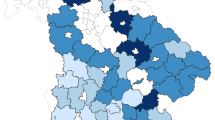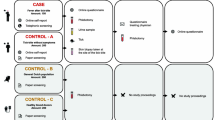Abstract
Purpose
There are more than 500,000 employees in Germany alone who are at risk of being bitten by a tick at their workplace and thus also at risk of being infected with Borrelia burgdorferi s.l. or the tick-borne meningoencephalitis virus. So far, there are only a small number of studies on the risk of tick bites in Central Europe, in particular, for military personnel during relevant training activities.
Methods
During a total of 36 months of training in 2008/2009 and from 2012 to 2014, the number of tick bites and any resulting diseases of 1156 recruits under comparable conditions of exposure and prevention were documented based on their medical records. The incidence of tick bites was calculated with each recruit’s individual exposure time for field training.
Results
There were a total of 66 tick bites during an exposure time of 317,059 h of field training (0.21 tick bites per 1000 h of training). The risk of tick bites was found to have a seasonal dependency. In 6 out of the 66 cases in which someone was bitten, the patients consulted a physician for a follow-up examination, and in one of these cases the bite resulted in an infection requiring treatment.
Conclusions
It turns out that there is a rather low but relevant risk of being exposed to tick bites for military personnel during their field training. Under the given study conditions, months with a high risk of tick bites can be distinguished from months with a low risk of tick bites, which is of vital importance, in particular, for guidance and prevention.

Similar content being viewed by others
References
Dobler G, Aspöck H (2010) Tick-borne arboviruses causing infections in humans. Denisia 30:467–499
Faulde MK, Scharninghausen J, Tisch M (2008) Preventive effect of permethrin-impregnated clothing to Ixodes ricinus ticks and associated Borrelia burgdorferi s.l. in Germany. Int J Med Microbiol 298(S1):321–324
Faulde MK, Rutenfranz M, Hepke J, Rogge M, Görner A, Keth A (2014) Human tick infestation pattern, tick-bite rate, and associated Borrelia burgdorferi s.l. infection risk during occupational tick exposure at the Seedorf military training area, northwestern Germany. Ticks Tick Borne Dis 5:594–599
Faulde M, Rutenfranz M, Keth A, Hepke J, Rogge M, Görner A (2015) Pilot study assessing the effectiveness of factory-treated, long-lasting permethrin-impregnated clothing for the prevention of tick bites during occupational tick exposure in highly infested military training areas, Germany. Parasitol Res 114:671–678
Frank C, Faber M, Hellenbrand W, Wilking H, Stark K (2014) Important vector-borne infectious diseases among humans in Germany. Epidemiological aspects. Bundesgesundheitsbl 57:557–567
Fülöp B, Poggensee G (2008) Epidemiological situation of Lyme borreliosis in Germany: surveillance data from six Eastern German States, 2002 to 2006. Parasitol Res 103(Suppl. 1):117–120
Gilbert L, Aungier J, Tomkins JL (2014) Climate of origin affects tick (Ixodes ricinus) host-seeking behavior in response to temperature: implications for resilience to climate change? Ecol Evol 4:1186–1198
Ginsberg H, Faulde MK (2008) Ticks. In: Bonnefoy X, Kampen H, Sweeney K (eds) Urban pests and health. WHO, Geneva, pp 303–345 (ISBN: 978-92-890-7188-8)
Lindquist L, Vapalahti O (2008) Tick-borne encephalitis. Lancet 371:1861–1871
Mowbray F, Amlôt R, Rubin GJ (2014) Predictors of protective behaviour against ticks in the UK: a mixed methods study. Ticks Tick Borne Dis 5:392–400
Qviller L, Grøva L, Viljugrein H, Klingen I, Mysterud A (2014) Temporal pattern of questing tick Ixodes ricinus density at different elevations in the coastal region of western Norway. Parasit Vectors 7:179
Rizzoli A, Hauffe HC, Carpi G, Vourc’h GI GI, Neteler M, Rosà R (2011) Lymeborreliosis in Europe. Euro Surveill 16(27):19906
Rossbach B, Kegel P, Zier U, Niemietz A, Letzel S (2014) Protective efficacy of permethrin-treated trousers against tick infestation in forestry workers. Ann Agric Environ Med 21:712–717
Statistisches Bundesamt (2018) Statistisches Jahrbuch 2018, Wiesbaden, 2018, pp 353–384
Zöldi V, Turunen T, Lyytikäinen O, Sane J (2017) Knowledge, attitudes, and practices regarding ticks and tick-borne diseases, Finland. Ticks Tick Borne Dis 8:872–877
Author information
Authors and Affiliations
Corresponding author
Ethics declarations
Conflicts of interest
The authors declare that there are no conflicts of interest.
Additional information
Publisher's Note
Springer Nature remains neutral with regard to jurisdictional claims in published maps and institutional affiliations.
Rights and permissions
About this article
Cite this article
Sammito, S., Müller-Schilling, L., Gundlach, N. et al. Workplace-related risk of tick bites in military personnel stationed in Northern Germany. Int Arch Occup Environ Health 92, 1061–1065 (2019). https://doi.org/10.1007/s00420-019-01445-0
Received:
Accepted:
Published:
Issue Date:
DOI: https://doi.org/10.1007/s00420-019-01445-0




